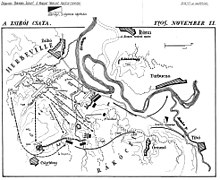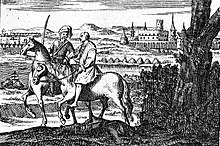Preparations
A 1704 campaign by Kuruc forces liberated much of Hungary from Austrian rule and established numerical parity with the Austrians. However, due to better training, a stronger officer corps and deeper logistical capabilities, the Austrians still won the decisive Battle of Nagyszombat, going on to take back the important fortresses of (Buda, Pressburg and Esztergom). The Austrians subsequently called on aid from Croatian, Serbian and Danish armies.
As a means of counterbalancing Austrian power, Louis XIV of France attempted to support the Kuruc rebels, sending troops and material support. However, following the French defeat at the battle of Höchstädt, Louis was forced to reduce his material contributions to Rákóczi and the Kurucs.
On 8 July 1704 the Transylvanian noble Rákóczi was elected Transylvanian prince, and on 4 April 1705 he was inducted. Designed to declare the confederation of Hungary and Transylvania, problems nonetheless occurred in the National Assembly of Szécsény over the army and the legal status of serfdom. Meanwhile, Rákóczi routed the new Habsburg army under Vienna.
On 27 June a Danish military detachment arrived in Vienna (4500 infantry and 1600 cavalry) under Andreas Harboe. The Danish soldiers fought against the French army in the battle of Höchstädt. The Danish-Austrian vanguard under col. Dietrich Glöckelsperg attacked Great Rye Island. Baron Herbeville mobilized his army on the island and on July 29 tried to march in Komárno, but withdrew on 3 August because of the Kuruc attacks. Meanwhile, Miklós Bercsényi and Antal Esterházy invaded Moravia. On 25 August Herbeville crossed the Transdanubia. In September he took a rest in Buda. The army of János Bottyán (6000 men) tried to disturb the Austrian army.
The Kuruc commanders committed serious errors: only in October did they respond to the attack of Herbeville. Rákóczi reinforced fortifications built near Zsibó, but wanted to fight a battle near Nagyvárad (today: Oradea, Romania). Later, the decision was changed to bring the battle to Zsibó. On 31 October Herbeville chased the Kuruc army from Nagyvárad, which had been besieged for two years. This was a serious defeat for the Kuruc army.
Opposing forces
Rákóczi's army was well equipped with food and the soldiers were relaxed. However many of the Kuruc soldiers were poorly trained. The French auxiliary troops of Marquis Des Alleurs, Rákóczi's court regiments (Hungarian, Rusyn and German soldiers) and the German mercenaries of Simon Forgách were trained and disciplined soldiers. Many Romanian soldiers served in the infantry and cavalry, which included a miscellaneous Hungarian-Romanian-Serbian mounted regiment. The combined forces of the Kuruc-French army numbered 15,000 men and 34 cannons. The Kuruc army was located in the trenches near Zsibó, but the trenches were not completely prepared.
Herbeville's army was starving, as Bottyán had used scorched-earth tactics against the Austrians and all the crops on Great Rye Island had been harvested. Nevertheless, the fighting morale of the army remained high. All military units were trained, equipped and disciplined, except for the irregular Serbian cavalry. Danish grenadiers, infantry and cavalry fought under Andreas Harboe and general Frederik Gersdorff. Jovan Popović vojvoda of Tököl commanded the Serbian light cavalry. The Austrian-Danish-Serbian army numbered 16,500 men.

Emeric Thököly de Késmárk was a Hungarian nobleman, leader of anti-Habsburg uprisings like his father, Count István Thököly, before him. Emeric was Prince of Upper Hungary, an Ottoman vassal state, from 1682 to 1685, and briefly Prince of Transylvania during the year 1690. Having formed an alliance with the Turks, Thököly assisted the Ottoman Empire at the Battle of Vienna in 1683 and led the Turkish cavalry at the Battle of Zenta. Refusing to surrender to Habsburg Emperor Leopold I, Thököly lost his principality of Upper Hungary and finally retired to Galata, near Constantinople, with large estates granted him by Mustafa II.
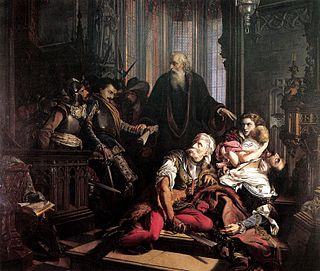
Kuruc, also spelled kurutz, refers to a group of armed anti-Habsburg insurgents in the Kingdom of Hungary between 1671 and 1711.
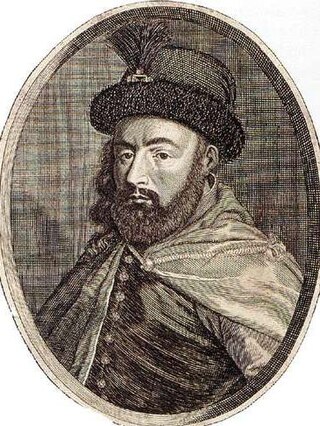
George II Rákóczi, was a Hungarian nobleman, Prince of Transylvania (1648-1660), the eldest son of George I and Zsuzsanna Lorántffy.
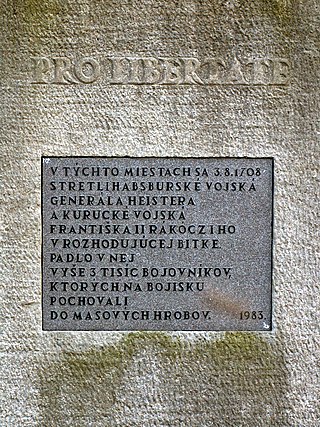
The Battle of Trenčín or Battle of Trencsén was fought between the Hungarian Kuruc forces of Francis II Rákóczi and the Imperial Army of the Habsburgs. It was part of Rákóczi's eight-year-long War of Independence.
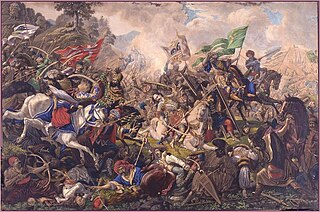
The Battle of Breadfield was the most tremendous conflict fought in Transylvania up to that time in the Ottoman–Hungarian Wars, taking place on October 13, 1479, on the Breadfield near the Saxon village of Alkenyér next to the river Maros (Mureș). The Hungarian army was led by Pál Kinizsi, István Báthory, Vuk Branković, and Basarab Laiotă cel Bătrân.

Rákóczi's War of Independence (1703–1711) was the first significant attempt to topple the rule of the Habsburgs over Hungary. The war was conducted by a group of noblemen, wealthy and high-ranking progressives and was led by Francis II Rákóczi and resigned soldiers and peasants fought alongside the noblemen. The insurrection was unsuccessful, ending with the Treaty of Szatmár; however, the Hungarian nobility managed to partially satisfy Hungarian interests.
The Battle of Saint Gotthard was fought on 13 December 1705 between a Hungarian (Kuruc) army led by János Bottyán and an Austrian-Croatian-Serbian combined army under the command of Hannibal von Heister. The battle took place at Szentgotthárd and Nagyfalva (Mogersdorf), near the Austro-Hungarian border. The result of the battle was a Hungarian victory.
The Battle of Tarcal or Battle of Tokaj was fought on 27 September 1527 near Tokaj between the Habsburg-German-Hungarian forces of Archduke Ferdinand of Austria and an opposing Hungarian army under the command of John Zápolya. Ferdinand defeated Zápolya.
The Battle of Szina or Seňa took place near Szina in the Kingdom of Hungary. The battle was fought on 20 March 1528 between two rival kings of Hungary John Zápolya and Ferdinand I. The latter's forces under command of Bálint Török and Johann Katzianer, a Styrian mercenary commander defeated John's army; the battle was the second military defeat for John Zápolya during the civil war.
The Battle of Szőlős or Battle of Seleš was fought on May 1, 1527 between the ethnic Serbian Rebels and Hungarian nobility. The commander of the Serb forces was Emperor Jovan Nenad, while the Hungarians were led by Péter Perényi of Transylvania. The Hungarian army suffered a total defeat while Perényi barely escaped alive.
The Battle of Sződfalva or Battle of Sedfal field was fought on 25 July 1527 between voivodian Serbs, under Jovan Nenad, and the Transylvanian army of. In the battle, Jovan Nenad was defeated by a much larger force, and many of his troops dispersed into Syrmia after the defeat. When Ferdinand of Austria won, the Serbs maintained an autonomous principality in the area that lasted until 1540.

The Hungarian–Romanian War was fought between Hungary and Romania from 13 November 1918 to 3 August 1919. The conflict had a complex background, with often contradictory motivations for the parties involved.
The Battle of Humenné took place on 22–23 November 1619 near Humenné during the first period of the Thirty Years' War between the Transylvanian army and the joined loyalist Hungarian and Polish forces of Lisowczycy. It was the only battle of that war to involve the Polish–Lithuanian Commonwealth.
The Battle of Zernest was fought on 11 August 1690, near the town of Zernest in southeastern Transylvania, between the allied forces of Transylvania and the Holy Roman Empire, and the allied forces of the Ottoman Empire, Tatar allies, Wallachians, and Hungarian Kurucs.
The Battle of Smolenice was a battle between the Kuruc, and the forces of the Habsburg Empire, soldiers of the Holy Roman Empire and auxiliaries from Denmark. The battle occurred on 28 May 1704 at Smolenice in Upper Hungary, where the Kuruc army routed the Habsburg forces, capturing the Austrian commander. For a short time, the rebels threatened the safety of Vienna, marauding through a number of villages in Lower Austria, Marchfeld, and Moravia.
The Battle of Zvolen took place between the Kuruc's and the army of Habsburg monarchy on 15 November 1703 at Zvolen in Upper Hungary. General Miklós Bercsényi was routed by the Austrian army under Simon Forgách. Forgách in 1704 went over to the Kuruc side.
The Battle of Biskupice took place between the Kuruc (Hungarians) and the Danish auxiliaries of the Habsburg army on 21 April 1704.

The Battle of Koroncó took place on 13 June 1704 at Koroncó in Győr County, Hungary between the Kurucs (Hungarians) and the army of Habsburg Empire. The Kuruc army was defeated in the battle. Although the Austrian army retired to Austria after the battle, the Kuruc positions in the Dunántúl remained uncertain until 1705 because of the fiasco near Koroncó.

The Battle of Vízakna was a battle in the Hungarian war of Independence of 1848-1849 fought on 4 February 1849 between the Hungarian army led by the Polish General Józef Bem and the Austrian army of the Habsburg Commander-in-Chief of Transylvania, Lieutenant General Anton Puchner. The Hungarian national poet Sándor Petőfi participated in the battle in the Hungarian army, then wrote a poem entitled Négy nap dörgött az ágyú in which he described the battle. The Austrian forces, who had a significant numerical superiority, were victorious, almost entirely destroying the Hungarian army. Unfortunately after the battle many Hungarian soldiers who could not retreat with the troops, or remained wounded on the battlefield, were killed by the Austrians and their Romanian militia allies, as an act of war crime. With this defeat, all of Bem's previously gained achievements were put in jeopardy, but Bem's skillful operations in the following weeks turned the struggle for Transylvania back in his favour.

The Battle of Piski was a battle in the Hungarian war of Independence of 1848-1849 fought on 9 February 1849 between the Hungarian army led by the Polish General Józef Bem and the Austrian army of the Habsburg Commander-in-Chief of Transylvania, Lieutenant General Anton Puchner. As a result of the defeats suffered by Bem against the much superior Austrian army, supported also by Romanian and Saxon militias, and a Russian army of several thousand soldiers, the Hungarian army was about to be pushed out of Transylvania. This is why this battle was a crucial one for Bem. And thanks to the reinforcements sent from Hungary, he could stop the Austrian attack at Piski, defeat Puchner, and restart the fight for the province.
